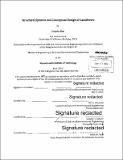| dc.contributor.advisor | Pierre Ghisbain and Jerome. J. Connor. | en_US |
| dc.contributor.author | Han, Lingxiao, M. Eng. Massachusetts Institute of Technology | en_US |
| dc.contributor.other | Massachusetts Institute of Technology. Department of Civil and Environmental Engineering. | en_US |
| dc.date.accessioned | 2014-09-19T21:34:39Z | |
| dc.date.available | 2014-09-19T21:34:39Z | |
| dc.date.copyright | 2014 | en_US |
| dc.date.issued | 2014 | en_US |
| dc.identifier.uri | http://hdl.handle.net/1721.1/90017 | |
| dc.description | Thesis: M. Eng., Massachusetts Institute of Technology, Department of Civil and Environmental Engineering, 2014. | en_US |
| dc.description | Cataloged from PDF version of thesis. | en_US |
| dc.description | Includes bibliographical references (pages 109-110). | en_US |
| dc.description.abstract | Cantilevers are a popular way to express form and create unique feature spaces. From a design perspective, cantilevers are amazing feats for the built environment, and structurally, present many opportunities. However, conceptual cantilever design can be a difficult task for Architects and Structural Engineers because there are many structural systems or strategies designers could choose to carry loads to supports. This thesis begins with examples of built cantilevers which are distilled into five categories of structural systems. These structural systems serve as the beginning of the design process. In addition to choosing a structural system, there are many parameters of a cantilever that can be altered that all impact the overall structural performance to varying degrees. This thesis proposes to study these parameters to better understand how they relate to one another through analytical derivations of global deflection and member forces. Secondly, with these analytical relationships, this thesis attempts to quantitatively measure the effectiveness of each structural system through an optimization sequence that takes into account both material use and deflection criteria. This method of optimization can then be applied to particular examples and be used as a systematic approach to conceptual cantilever design. A design example is optimized for material weight while satisfying a given deflection criteria, as a way to illustrate the differences between each structural system. | en_US |
| dc.description.statementofresponsibility | by Lingxiao Han. | en_US |
| dc.format.extent | 110 pages | en_US |
| dc.language.iso | eng | en_US |
| dc.publisher | Massachusetts Institute of Technology | en_US |
| dc.rights | M.I.T. theses are protected by copyright. They may be viewed from this source for any purpose, but reproduction or distribution in any format is prohibited without written permission. See provided URL for inquiries about permission. | en_US |
| dc.rights.uri | http://dspace.mit.edu/handle/1721.1/7582 | en_US |
| dc.subject | Civil and Environmental Engineering. | en_US |
| dc.title | Structural systems and conceptual design of cantilevers | en_US |
| dc.type | Thesis | en_US |
| dc.description.degree | M. Eng. | en_US |
| dc.contributor.department | Massachusetts Institute of Technology. Department of Civil and Environmental Engineering | |
| dc.identifier.oclc | 890136898 | en_US |
